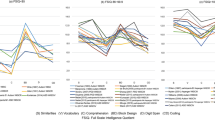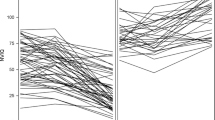Abstract
Extant data suggest that the cognitive profiles of individuals with ASD may be characterized by variability, particularly in terms of verbal intellectual functioning (VIQ) and non-verbal intellectual functioning (NVIQ) discrepancies. The Differential Ability Scales, Second Edition (DAS-II) has limited data available on its use with youth with ASD. The current study examined data from 2,110 youth with ASD in order to characterize performance on the DAS-II and to investigate potential discrepancies between VIQ and NVIQ. A larger proportion of individuals in the ASD sample had significant discrepancies between VIQ and NVIQ when compared to the normative sample [early years sample χ2 (2) = 38.36; p < .001; school age sample χ2 (2) = 13.48; p < .01]. Clinical and research implications are discussed.



Similar content being viewed by others
References
American Psychiatric Association. (2013). Diagnostic and statistical manual of mental disorders (5th ed.). Arlington, VA: American Psychiatric Association.
Ankenman, K., Elgin, J., Sullivan, K., Vincent, L., & Bernier, R. (2014). Nonverbal and verbal cognitive discrepancy profiles in autism spectrum disorders: Influence of age and gender. American Journal on Intellectual and Developmental Disabilities, 1, 84–99. doi:10.1352/1944-7558-119.1.84.
Beran, T. (2007). Review of the differential ability scales (2nd ed.). Canadian Journal of School Psychology, 22, 128–132. doi:10.1177/0829573507302967.
Black, D. O., Wallace, G. L., Sokoloff, J. L., & Kenworthy, L. (2009). Brief report: IQ split predicts social symptoms and communication abilities in high-functioning children with autism spectrum disorders. Journal of Autism and Developmental Disorders, 39(11), 1613–1619.
Chapman, N. C., Estes, A., Munson, J., Bernier, R., Webb, S. J., Rothstein, J. H., et al. (2011). Genome-scan for IQ discrepancy in autism: evidence for loci on chromosomes 10 and 16. Human Genetics, 129, 59–70. doi:10.1007/s00439-010-0899-z.
Coolican, J., Bryson, S., & Zwaigenbaum, L. (2008). Brief report: Data on the Stanford–Binet intelligence scales (5th ed.) in children with autism spectrum disorder. Journal of Autism and Developmental Disorders, 38, 190–197. doi:10.1007/s10803-007-0368-2.
Dumont, R., Willis, J. O., & Elliott, C. D. (2009). Essentials of DAS-II assessment. Hoboken, NJ: Wiley.
Elliott, C. D. (1991). Differential Ability Scales (DAS). San Antonio, TX: Harcourt Assessment.
Elliott, C. D. (2007a). Differential Ability Scales—Second edition (DAS-II). San Antonio, TX: Harcourt Assessment.
Elliott, C. D. (2007b). Differential ability scales, 2nd edition: Introductory and technical handbook. San Antonio, TX: Harcourt Assessment.
Filipek, P., Accardo, P., Ashwal, S., Baranek, G., Cook, E., Dawson, G., et al. (2000). Practice parameter: Screening and diagnosis of autism: Report of the quality standards subcommittee of the American academy of neurology and the child neurology society. Neurology, 55, 468–479.
Fischbach, G. D., & Lord, C. (2010). The simons simplex collection: A resource for identification of autism genetic risk factors. Neuron, 68(2), 192–195.
Flanagan, D. P., Ortiz, S. O., & Alfonso, V. C. (2013). Essentials of psychological assessment: Essentials of cross battery assessment (3rd ed.). Hoboken, NJ: Wiley.
Flanagan, D. P., & Kaufman, A. S. (2004). Essentials of WISC-IV assessment. Hoboken, NJ: Wiley.
Johnson, C., & Myers, S. (2007). Identification and evaluation of children with autism spectrum disorders. American Academy of Pediatrics Policy, 120(5), 1183–1215. doi:10.1542/peds.2007-2361.
Joseph, R. M., Tager-Flusberg, H., & Lord, C. (2002). Cognitive profiles and social-communicative functioning in children with autism spectrum disorder. Journal of Child Psychology and Psychiatry, 43(6), 807–821. doi:10.1111/1469-7610.00092.
Klin, A., Saulnier, C., Tsatsanis, K., & Volkmar, F. (2005). Clinical Evaluation in Autism Spectrum Disorders: Psychological Assessment within a Transdisciplinary Framework. In F. R. Volkmar, R. Paul, A. Klin, & D. Cohen (Eds.), Handbook of autism and pervasive developmental disorders, vol 1: Assessment, interventions, and policy (3rd ed., pp. 772–798). Hoboken, NJ US: Wiley.
Klinger, L., & Renner, P. (2000). Performance-based measures in autism: Implications for diagnosis, early detection, and identification of cognitive profiles. Journal of Clinical Child Psychology, 29(4), 479–492. doi:10.1207/S15374424JCCP2904_3.
Kuschner, E. S., Bennetto, L., & Yost, K. (2007). Patterns of nonverbal cognitive functioning in young children with autism spectrum disorders. Journal of Autism and Developmental Disabilities, 37(5), 795–807. doi:10.1007/s10803-006-0209-8.
Lennen, D. T., Lamb, G. D., Dunagan, B. J., & Hall, T. A. (2010). Verbal prowess equals higher IQ: Implications for evaluating autism. Research in Autism Spectrum Disorders, 4(1), 95–101. doi:10.1016/j.rasd.2009.09.004.
Lincoln, A., Courchesne, E., Allen, M., Hanson, E., & Ene, M. (1998). Neurobiology of Asperger syndrome: Seven case studies and quantitative magnetic resonance imaging findings. In E. Schopler, G. Mesibov, & L. J. Kunce (Eds.), Asperger Syndrome or High-functioning Autism? (pp. 145–166). New York: Plenum.
Lord, C., Petkova, E., Hus, V., Gan, W., Lu, F., Martin, D. M., et al. (2011). A multisite study of the clinical diagnosis of different autism spectrum disorders. Archives of General Psychiatry,. doi:10.1001/archgenpsychiatry.2011.148.
Lord, C., Risi, S., Lambrecht, L., Cook, E., Leventhal, B., DiLavore, P., et al. (2000). The autism diagnostic observation schedule—Generic: A standard measure of social and communication deficits associated with the spectrum of autism. Journal of Autism and Developmental Disorders, 30, 205–223. doi:10.1023/A:1005592401947.
Mayes, S., & Calhoun, S. L. (2003). Analysis of WISC-III, Stanford–Binet: IV, and academic achievement test scores in children with autism. Journal of Autism and Developmental Disorders, 33(3), 329–341. doi:10.1023/A:1024462719081.
National Research Council. (2001). Diagnosis, assessment, and prevalence. In C. Lord & J. P. McGee (Eds.), Educating children with autism (pp. 23–31). Washington, DC: National Academy Press.
Rutter, M., LeCouteur, A., & Lord, C. (2003). Autism Diagnostic Interview-Revised. Lutz, FL: PAR.
Sattler, J. M. (2008). Assessment of children: Cognitive applications (5th ed.). San Diego, CA: Author.
Semrud-Clikeman, M., Walkowiak, J., Wilkinson, A., & Christopher, G. (2010). Neuropsychological differences among children with Asperger syndrome, nonverbal learning disabilities, attention deficit disorder, and controls. Developmental Neuropsychology, 35(5), 582–600. doi:10.1080/875656412010494747.
Siegel, D., Minshew, N., & Goldstein, G. (1996). Wechsler IQ profiles in diagnosis of high-functioning autism. Journal of Autism and Developmental Disorders, 26, 389–406. doi:10.1007/BF02172825.
Acknowledgments
This research was supported by a grant from the Simons Foundation (SFARI SSC-15 to R. Goin-Kochel and A. Beaudet). We are grateful to all of the families at the participating SFARI Simplex Collection (SSC) sites, as well as the principal investigators (A. Beaudet, R. Bernier, J. Constantino, E. Cook, E. Fombonne, D. Geschwind, D. Grice, A. Klin, D. Ledbetter, C. Lord, C. Martin, D. Martin, R. Maxim, J. Miles, O. Ousley, B. Peterson, J. Piggot, C. Saulnier, M. State, W. Stone, J. Sutcliffe, C. Walsh, E. Wijsman). We appreciate obtaining access to phenotypic data on SFARI Base. Approved researchers can obtain the SSC population dataset described in this study (https://ordering.base.sfari.org/~browse_collection/archive[sfari_collection_v14]/ui:view()) by applying at https://base.sfari.org.
Author information
Authors and Affiliations
Corresponding author
Rights and permissions
About this article
Cite this article
Nowell, K.P., Schanding, G.T., Kanne, S.M. et al. Cognitive Profiles in Youth with Autism Spectrum Disorder: An Investigation of Base Rate Discrepancies using the Differential Ability Scales—Second Edition. J Autism Dev Disord 45, 1978–1988 (2015). https://doi.org/10.1007/s10803-014-2356-7
Published:
Issue Date:
DOI: https://doi.org/10.1007/s10803-014-2356-7




